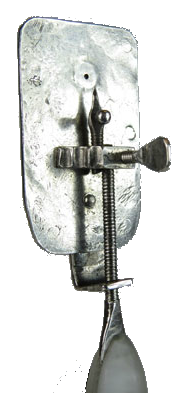Constructing the microscopes
What do we know?
Leeuwenhoek made the microscopes himself, both the metal parts and the lenses. In his letter of January 12, 1689, he wrote in great detail about the parts of the eel viewers and fish viewers and how the parts worked together. In that letter and others, he made reference to using common blacksmithing tools.
What don't we know?
Leeuwenhoek wrote nothing specifically about the single-lens microscopes or how he made and assembled them. He had been making them for well over a decade before he developed the larger viewers for live specimens. It seems reasonable that he made the viewers applying the techniques he used for so long making the single-lens microscopes.
The 248x silver microscope below is the newest addition to the group, the eleventh surviving Leeuwenhoek microscope, and the first discovered since 1983. It was authenticated by curator Tiemen Cocquyt and his team at the Boerhaave Museum in 2015.
 |
 |
 |
By what process did this beauty come into service?
On the right sidebar, this process is divided into five phases using this silver microscope as an example.
- Phase I: Preparing the parts made from metal plates
- Phase II: Preparing the mount
- Phase III: Preparing the parts made from metal rods
- Phase IV: Preparing the focusing system of bracket/mount/screws
- Phase V: Assembling the parts
The first three of the five phases could have been done in any order. The different silver purity for different parts of an individual microscope suggests that Leeuwenhoek used a batch method to make the parts. The fourth phase depends on the third. All of the first four phases had to be completed before Leeuwenhoek could begin the fifth phase, actually assembling the parts.
My discussion here of Leeuwenhoek's process is based solely on inferences from the scant evidence in his letters and from observation of the microscopes.
It is also informed by:
- articles written by Hans Loncke (2007), Al Shinn (1996), and George Carboni (1996), who made replica microscopes
- articles written by J. van Zuylen (1981) and Marian Fournier (2002), who studied ten of the then-eleven extant microscopes
- conversations with Auke Gerrits of the Boerhaave Museum (2015), who helped authenticate the newly discovered twelfth microscope
The three views of the whole microscope as well as the close-ups on the other pages come from the Boerhaave's authentication team.











